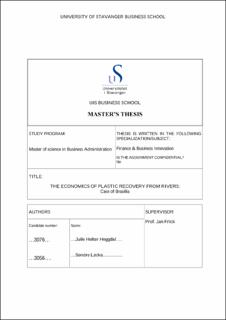| dc.contributor.advisor | Frick, Jan | |
| dc.contributor.author | Løcka, Sondre | |
| dc.contributor.author | Heggdal, Julie Holter | |
| dc.date.accessioned | 2020-09-21T14:19:28Z | |
| dc.date.available | 2020-09-21T14:19:28Z | |
| dc.date.issued | 2020-06 | |
| dc.identifier.uri | https://hdl.handle.net/11250/2678878 | |
| dc.description | Master's thesis in Business Innovation | en_US |
| dc.description.abstract | The background issue regards the increasing amount of ocean plastics during the most recent years. Our focus of this issue will be on the plastic that is transported by rivers. We will address the problem by looking at existing river-plastic extractions initiatives, and the extraction technologies used. To look at waste plastics quantity in rivers, we found it relevant to make a choice of location and analyse the effort for specific circumstances. During our workshop of collaboration, the choice of location fell on Brasilia.
This research contains collaboration across study fields to gain knowledge of river waste recovery and local knowledge of Brasilia. This thesis will first of all, address the most relevant extraction methods where two solutions are chosen for estimations. To collect all the solutions available, it has been used public information and relevant contacts in the market to get a concrete understanding of the practices. River waste plastic recovery is a complex study and can be done from many perspectives. Our choice of focus is on cost and benefit from a private and social economic view.
The river is a part of the public environment property that is used for social activities and it will be important to address whether responsibility and procedures should be found on a macro or micro level of society. All over the world there are parties undertaking initiatives for mitigation of waste leakage and promotion of cleaning up. These are significant initiatives that involve private actors. To be able to contribute to today’s position and considering the need of collaboration between the governmental and the private actors, we found it important to address the equilibrium between these two players in the benefit-cost validation.
Regarding plastic waste, we find it important to contribute to how private initiatives can better outbreak this market failure of negative externality. In the final findings we address the costs of the two extraction systems and the investment required by the system itself. We also find it valuable to see the examination from private actors and how a given initiative can receive investment from the public sector. In the final result the collaboration of private actor and public actor will be outlined as a contract containing the quantitative indicators for investment decision. | en_US |
| dc.language.iso | eng | en_US |
| dc.publisher | University of Stavanger, Norway | en_US |
| dc.relation.ispartofseries | Masteroppgave/UIS-HH/2020; | |
| dc.rights | Navngivelse 4.0 Internasjonal | * |
| dc.rights.uri | http://creativecommons.org/licenses/by/4.0/deed.no | * |
| dc.subject | anvendt finans | en_US |
| dc.subject | økonomi | en_US |
| dc.subject | administrasjon | en_US |
| dc.subject | innovasjon | en_US |
| dc.title | The Economics of plastic recovery from rivers | en_US |
| dc.type | Master thesis | en_US |
| dc.description.version | submittedVersion | en_US |
| dc.subject.nsi | VDP::Samfunnsvitenskap: 200::Økonomi: 210::Bedriftsøkonomi: 213 | en_US |

